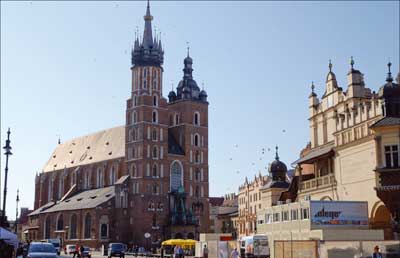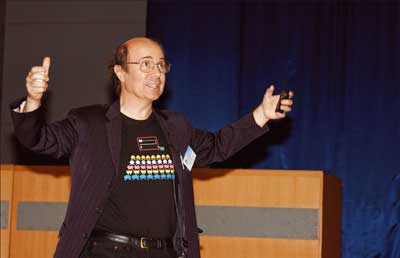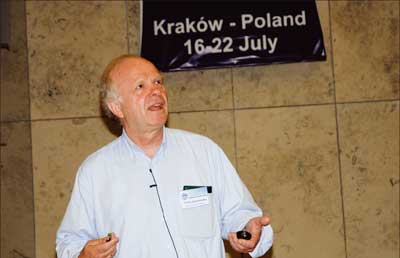A report from Europe’s major international particle physics meeting.

The 13th-century merchants’ town of Krakow and former capital is now one of the largest and oldest cities in Poland. The scenic city centre – a UNESCO World Heritage Site – with its fascinating history and pleasant climate, provided the perfect setting for discussing new results and future developments at the biennial European Physical Society (EPS) conference on High Energy Physics (HEP). The event was held on 16–22 July at the new conference centre of the Jagiellonian University – the Auditorium Maximum.
The conference began with 35 parallel sessions and more than 350 contributions over two and a half days. Then, as is tradition, the EPS and European Committee for Future Accelerators scheduled a joint plenary meeting for Saturday afternoon. This focused on a number of talks concerning the future of the field: with Christian Spiering of DESY on “Astroparticle physics and relations with the LHC”; CERN’s director-general, Rolf Heuer, on “The high-energy frontier”; Alain Blondel of Geneva University on “The future of -accelerator-based neutrino physics'”; and Tatsuya Nakada of the École Polytechnique Fèdèrale de Lausanne on “Super-B factories”. Each presentation was followed by a lively discussion.
Sunday provided the opportunity for several sightseeing trips in and around Krakow. Monday saw a fresh start to the week and time for another tradition: the presentation of the EPS awards. For the first time, the High Energy and Particle Physics (EPS HEPP) prize was awarded to an experimental collaboration, Gargamelle, for the observation of the weak neutral current. After the awards ceremony, Frank Wilczek, the 2004 Nobel laureate, gave a special talk on “some ideas and hopes for fundamental physics”. This provided an excellent start to three days of plenary sessions, with around 35 presentations.
The Standard Model still reigns

The Tevatron proton–antiproton collider continues its smooth operation. With more than 6 fb–1 integrated luminosity delivered and peak luminosities exceeding 3.5 × 1032 cm–2s–1, the CDF and DØ experiments are steadily increasing their statistics. Both collaborations are pushing forward on the analysis of their latest data in a joint effort to confirm and enlarge the previously reported exclusion region for the Higgs mass of around 160–170 GeV. At the same time, several new ideas are emerging on how to improve the sensitivity of these experiments to more challenging Higgs decay channels. In addition to the direct search for the Higgs boson, both collaborations reported on new mass measurements of the W boson (MW = 80.399 ± 0.023 GeV) and confirmed the combined experimental result for the top quark mass (mt = 173.1 ± 1.3 GeV), pushing the error below the 1% level. These values lead to a further reduction of the preferred mass region for the Standard Model Higgs, as John Conway of the University of California Davis pointed out in his plenary presentation. Moreover, these and other precision measurements of the weak parameters (sin2θW = 0.2326 ± 0.0018stat ± 0.0006sys as compared with the theoretical prediction of sin2θW = 0.23149 ± 0.00013) show growing evidence that the Standard Model prefers a light Higgs, which, as Conway concluded, will make life difficult. Even for the large LHC experiments, ATLAS and CMS, this region of the window on the Higgs mass will require high statistics, combining different decay modes and sophisticated analyses.
A number of sophisticated statistical procedures are being developed and becoming available as complete software packages – for example, GFITTER – to simplify or fine-tune multidimensional analyses of experimental data. At the same time, there is impressive progress in calculating amplitudes for multileg processes and loops. A rather complete set of automatically derived “2 → 4 particle” cross-sections (the “Les Houches 2007 wish list”) demonstrates that higher-order corrections to important physics processes at the LHC cannot be ignored.

Increasing statistics at the Tevatron are also consolidating the observation of single top production, but at the same time the parameter space for new physics at or below the 1 TeV scale is becoming smaller, as Volker Büscher of Mainz explained. CDF and DØ have conducted studies that probe mass values for the charginos of supersymmetry up to 176 GeV; they find no evidence for neutralino production in their current data sample. In addition, the studies shift the possibility of quark compositeness or large extra dimensions further towards a higher energy scale.
While the latest updates on analyses of data from RHIC and the SPS were presented in the parallel sessions, Urs Wiedemann of CERN covered theoretical aspects of collective phenomena in his plenary talk. He summarized the motivation for experiments at RHIC (√sNN = 200 GeV) and the LHC (√sNN = 5500 GeV) to study the QCD properties of dense matter at the 150 MeV scale, which will be accessible at these high collision energies.
A wealth of new data is also emerging from the experimental analysis of B-physics – from both hadron colliders and e+e– machines – ranging from analyses of rare exclusive decay modes to spectroscopy and physics related to the Cabibbo–Kobayashi–Maskawa matrix (CKM). The results further confirm oscillations in the neutral D and Bs sectors. This is another area where the Standard Model seems not to be seriously challenged: the CKM triangle appears to remain “closed” (within experimental errors). Nevertheless, as Andrzej Buras of TU Munich pointed out in his talk on “20 goals in flavour physics for the next decade”, there are still many challenges ahead. A breakthrough could come with firm experimental evidence for flavour-changing neutral currents in excess of Standard Model predictions. Buras’s message is clear: stay focused on the many observables that are not yet well measured and the decay modes that are not so far (or poorly) studied; spectacular deviations from the Standard Model remain possible.

With a new series of experiments under construction and several experiments producing new data, neutrino physics remains an experimentally driven enterprise. The neutrino sessions were – not surprisingly – very well attended. Better mass measurements are coming within reach, be it from obtaining upper limits by measuring time shifts in neutrinos from supernovae (mν < 30 eV) or from measuring the tritium β-decay spectrum (mν < 2 eV) or mass differences from oscillations (all Δm2 < 1 eV2). Because neutrinos are abundant in the universe, even a small neutrino mass will have implications in astrophysics. Dave Wark of Imperial College summarized the broad spectrum of neutrino physics experiments and their discovery potential. Anticipating the various experimental approaches and progress, he explained under which terms the Majorana phases, for example, could be determined.
New frontiers – on Earth and in space

While the large LHC experiments are commissioning their triggers, new ideas on the future of the LHC machine are being explored. These include high-luminosity schemes and higher beam energies, which will have different implications for future upgrades of both machine and experiments. R&D on accelerators is focusing not only on higher-energy frontiers and currents, but also on more efficient beam-crossing (“crab”) scenarios.
In a worldwide effort, the International Linear Collider collaboration aims to present a Technical Design Report in 2012 for a high-energy e+e– machine. The Compact Linear Collider Study (CLIC) based at CERN, which aims for a Conceptual Design Report at the end of 2010, investigates different approaches and may reach a higher beam energy (3 TeV v 1 TeV). However, the physics simulations and detector designs for the two schemes face equal challenges.
The development of “super factories” is an ongoing effort that is complementary to the high-energy machines. These facilities should provide high-statistics experiments on, for example, the neutrino, charm and bottom sectors, with the necessary infrastructure for high-precision measurements. Caterina Biscari of Frascati presented a comprehensive overview of existing machines and (possible) future accelerators, in which she compared their main parameters.

The conference saw substantial contributions from astroparticle physics. The Auger experiment probing the highest energy cosmic rays (1020 eV) shows growing evidence for the Greisen–Zatsepin–Kuzmin cut-off. The energy spectrum agrees well (within the 25% calibration uncertainty on the energy scale) with results from the HiRes collaboration. Active galactic nuclei are now also observed by the High Energy Stereoscopic System (HESS) and the Large Area Telescope on the Fermi Gamma-ray Space Telescope. In particular, the core of Centaurus A appears to be extremely interesting owing to the bright radio source in its centre. High-energy cosmic rays are predominantly produced by “nearby” (< 100 Mpc) sources, while there is a slight indication that the composition changes with increasing energy, towards more heavy nuclei.
PAMELA (launched in 2006), the Advanced Thin Ionization Calorimeter balloon experiment (2008), Fermi (launched in 2008) and HESS show some excesses in the e± spectrum. The interpretation of these signals remains uncertain. Is it related to the nature of non-baryonic, that is, dark matter, or can the spectra be explained by astrophysics phenomena such as pulsars or supernova remnants? The PAMELA data have generated huge theoretical interest resulting in a multitude of dark-matter models. However, much more data are needed from both space-based experiments and ground-based searches for decaying weakly interacting massive particles. The Alpha Magnetic Spectrometer, finally scheduled to be launched in 2010, should at least provide much improved limits on the antiproton flux.
The next international Europhysics conference on high-energy physics will take place in Grenoble on 21–27 July 2011. After last years’ successful injection of proton beams into the LHC, followed by the unfortunate incident and subsequent repairs and consolidation, the starting date for high-energy collisions at the LHC is now rapidly approaching. At the meeting in Grenoble there will be lively discussions on Tevatron data – perhaps with surprises – and extensive reports, among others, on dark-matter searches. Of course, we all look forward to reports on first data analyses by the LHC experiments.
• The local organization of EPS-HEP 2009 by the Institute of Nuclear Physics PAN, Jagiellonian University, the AGH University of Science and Technology and the Polish Physical Society is acknowledged.






